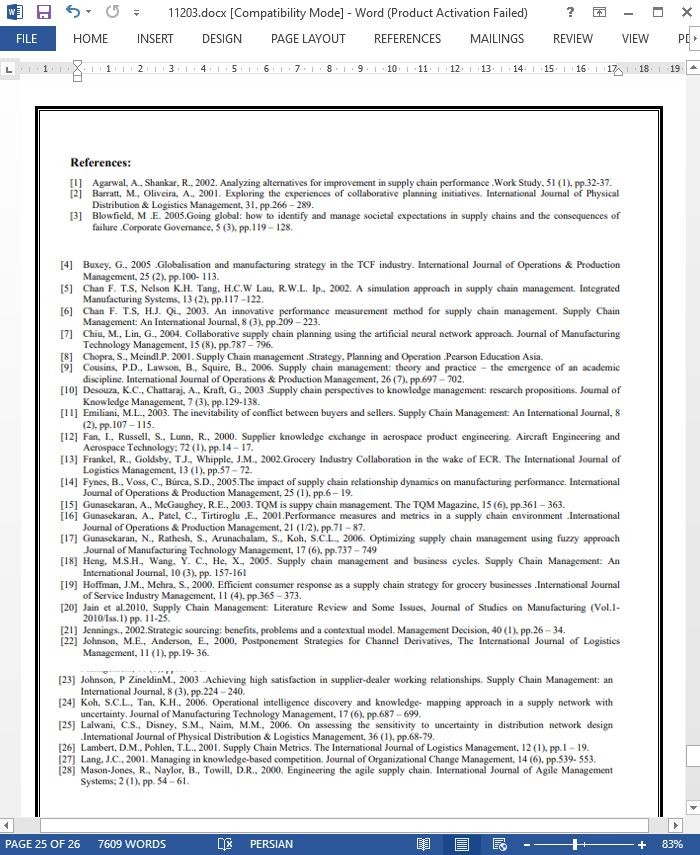
درک زنجیره تامین: بررسی متون و مقالات گذشته
چکیده
مدیریت زنجیره تامین شبکه ای از امکانات است که مواد اولیه را تولید می کند، آنها را به کالاهای واسطه تبدیل می کند و پس از آن محصولات نهایی و ارائه محصولات به مشتریان از طریق یک سیستم توزیع انجام می شود. مدیریت زنجیره تامین و نقش بازیگران مختلف درگیر از صنعتی به صنعت دیگر و شرکتی به شرکت دیگر متفاوت است. در نتیجه مدیریت زنجیره تامین (SCM) به یک مسئله حیاتی برای تولید کنندگان، متخصصان و پژوهشگران تبدیل شده است. احساس می شود که برای مدیریت زنجیره تامین کل ساختار زنجیره تامین باید به طور موثر و به درستی درک شود.
در این مقاله تلاش شده است تا به خواننده یک تصویر کامل از مدیریت زنجیره تامین از طریق بررسی سیستماتیک متون گذشته ارائه شود. این مقاله فعالیت های اصلی زنجیره تامین و رویکرد گام به گام برای درک یک تصویر کامل از زنجیره تامین را ارائه می کند.
1. مقدمه
سازمان ها روش های متعدد بهبود کسب و کار های را به منظور بهبود عملکرد کسب و کار اتخاذ می کنند. تولید کنندگان و محققان تعدادی از مشکلات مربوط به فعالیت های زنجیره تامین در تحقیق و شیوه خود اشاره کرده اند (اسدیهاران و همکاران، 2005). مشهود است که معمولا یا یک سیستم (رویکرد یکپارچه) و یا جزء فرعی در زنجیره تامین (رویکرد از هم پاشیده) در متون گذشته متمرکز و مورد بحث شده است، اما نتوانستند پاسخ منطقی (چرا، چیستی، چگونگی) در پشت فعالیت های زنجیره تامین بیابند ( اسپنس و بسک ، 2002). این مقاله این پرسشها را با کمک بررسی متون و مقالات ساختاری گذشته مطرح می کند که نه تنها به درک مدیریت زنجیره تامین کمک می کند بلکه یک رویکرد شش مرحله ای برای مدیریت زنجیره تامین را فراهم می کند.
8. بحث و نتیجه گیری
سازمان ها اهداف متعددی دارند مانند افزایش رقابت، خدمات بهتر به مشتریان و افزایش سودآوری و غیره. برای دنبال کردن این اهداف، سازمان ها سیستم های دفاعی های مختلفی را بکار می برند مانند راهکار بهبود عملکرد کسب و کار تهاجمی. رویکردی که ما بحث کردیم (SCM) تمام زمینه های کاربردی سازمان را پوشش می دهد. این مورد شبکه ای از مشتریان، تامین کنندگان، تولید کنندگان، توزیع کنندگان است و بر جریان مواد، اطلاعات و امور مالی از طریق منابع فیزیکی و انسانی متمرکز شده است.
Abstract
Supply Chain Management is a network of facilities that produce raw materials, transform them into intermediate goods and then final products, and deliver the products to customers through a distribution system. The management of the supply chain and the roles of various actors involved differ from industry to industry and company to company. As a result Supply Chain Management (SCM) has become a vital issue for manufacturers, professionals and researchers. It is felt that to manage the supply chain effectively entire structure of supply chain must be understood properly.
This paper attempts to provide the reader a complete picture of supply chain management through a systematic literature review. It presents main activities of supply chain and the step-by-step approach for understanding a complete picture of supply chain.
1. Introduction
Organizations adopt numerous business improvement methodologies to improve the business performance. Manufacturers and researchers have noted a number of problems regarding supply chain activities in their research and practice (Sridharan et al., 2005). It is observed that usually either a system (Integrated approach) or a subcomponent in supply chain (Disintegrated approach) is focused and discussed in the literature but fails to answer the rational (why, what, how) behind supply chain activities ( Spens & Bask, 2002). This paper addresses these questions with the help of structured literature review, which not only helps to understand the management of supply chain but also provide the a six step approach to manage the supply chain.
8. Discussion and Conclusion
Organizations have multiple objectives like enhanced competitiveness, better customer service and increased profitability etc. To seek these objectives organizations employ various defensive as well as offensive business performance improvement approaches. Approach we have discussed (SCM) covers all functional areas of organization. It is the network of customers, suppliers, manufacturers, and distributors concentrating the flows of material, information, and finance through physical and human resources.
چکیده
1. مقدمه
2. مرور مقالات
3. مدیریت زنجیره تامین
3.1 تکامل SCM
3.2 تعاریف و ایده های کلیدی SCM
3.3 مدیریت زنجیره تامین - مسائل و چالشها
3.4 اهداف مدیریت زنجیره تامین
3.5 موانع، روابط و مزایای SCM کارآمد
3.6 نیاز به مدیریت زنجیره تامین
4. مسائلی در زنجیره تامین
4.1 فناوری اطلاعات و مدیریت اطلاعات
4.2 مدیریت دانش
4.3 مسائل مربوط به مشتریان – تامین کننده
4.4 مسئله روابط مشتری
4.5 مسئله طراحی زنجیره تامین
4.6 مدیریت تدارکات
4.7 مسائل جهانی
4.8 مسائل مشارکت
4.9مسائل محیطی
4.10 اعتماد و تعهد
5. ارزیابی عملکرد در زنجیره تامین
5.1 اهمیت ارزیابی عملکرد
5.2 طبقه بندی اقدامات عملکردی
6. شیوه های مدیریت زنجیره تامین
7. مدیریت زنجیره تامین
8. بحث و نتیجه گیری
Abstract
1. Introduction
2. Review of Literature
3. Supply Chain Management
3.1 Evolution of SCM
3.2 Definitions and key ideas of SCM
3.3 Supply Chain Management - Issues and Challenges
3.4 Supply chain management objectives
3.5 Barriers, Bridges and Benefits to effective SCM
3.6 Need for Managing Supply Chain
4. Issues in Supply Chain
4.1 Information Technology and Information Management
4.2 Knowledge Management
4.3 Customers - Supplier Relationship Issues
4.4 Customer relations Issue
4.5 Issue of Supply chain Design
4.6 Logistics management
4.7 Global Issues
4.8 Partnership Issues
4.9 Environmental issues
4.10 Trust & Commitment
5. Performance Measurement in Supply Chain
5.1 Significance of Performance Evaluation
5.2 Performance measures Classification
6. Supply Chain Management Practices
7. Managing Supply Chain
8. Discussion and Conclusion
- اصل مقاله انگلیسی با فرمت ورد (word) با قابلیت ویرایش
- ترجمه فارسی مقاله با فرمت ورد (word) با قابلیت ویرایش، بدون آرم سایت ای ترجمه
- ترجمه فارسی مقاله با فرمت pdf، بدون آرم سایت ای ترجمه



